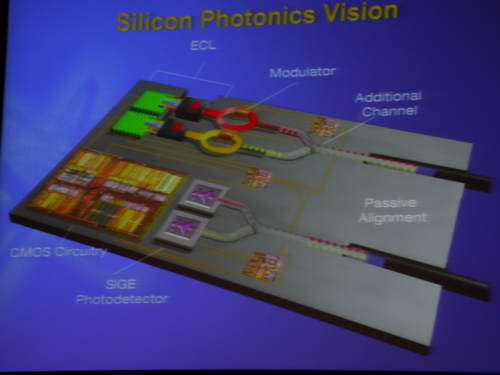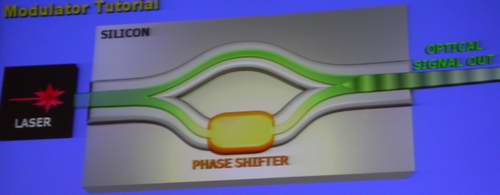Intel Developer Forum Spring 2003 - Day 1: New Concept PCs
by Anand Lal Shimpi on February 18, 2003 8:58 PM EST- Posted in
- Trade Shows
Silicon Photonics Once Again
The first demonstration that was a part of Craig Barrett's keynote was the first public showing of an Intel manufactured silicon based optical modulator.

The idea of integrating CMOS Circuitry and Silicon Photonics is a goal for
the future of microprocessor and silicon architecture in general
The idea behind Silicon Photonics, as Intel presented to the world at previous IDFs, is fairly simple; using light to send information within a chip, instead of conventional copper wires and electrons. Some of the major pathways within today's CPUs and platform architectures that currently exist in the form of wires and electrons will be replaced by lasers and paths to channel them. Imagine an extremely high bandwidth FSB that uses lasers to send data between your CPU and chipset, instead of the cumbersome wires that are used today.
Obviously we're not at that point today, but that's where Intel wants to be eventually. One technology that's taking them there is this silicon based optical modulator.
The purpose of the silicon based optical modulator is to take a light source and convert it into electrically compatible 0's and 1's. The idea is that the medium used for transmitting those 0's and 1's should not change the rules of the game that we've come to learn over the past several decades of dealing with CPU and computer architectures.

The optical modulator works by taking an input light source, in this case a laser, and splitting it into two signals - a reference and a phase shifted signal. If you're familiar with wave theory you'll know that you can add two signals of different phases and produce either one amplified signal or a signal with no amplitude - a binary 0 or a binary 1.

Intel used the optical modulator in combination with some conventional processors to send an image of Pat Gelsinger from one point to another; obviously nothing along the lines of an optical FSB as we mentioned earlier, but it's one of a series of first steps in a long journey to that point.










0 Comments
View All Comments